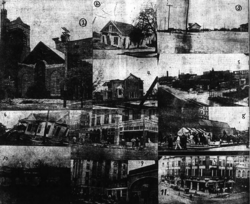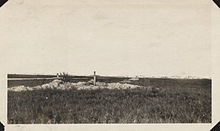1915 Galveston hurricane
Significant losses were reported to the island's banana, beet, and sugar plantations, while coastal surge washed out roads and destroyed wharves; fifteen people in Jamaica were killed.
During the early morning hours of August 17, the hurricane made landfall with winds of 130 mph (210 km/h) at San Luis Pass, Texas, approximately 26 mi (42 km) southwest of Galveston.
[3] The storm crossed into the Caribbean Sea the following day, passing south of St. Croix with growing intensity as indicated by rapidly falling pressures throughout the region.
[2] At 07:00 UTC on August 17—in the early morning hours—the hurricane made landfall near San Luis Pass, approximately 26 mi (42 km) southwest of Galveston, Texas.
Later anticipating that the hurricane would cross western Cuba, the Weather Bureau issued a northeast storm warning for Key West and Miami, Florida, on August 13.
[4] The head of the bureau's local office in Galveston, Texas, W. P. Stewart, cited the warnings as the sole reason for the relatively low number of fatalities in unprotected areas of the city.
[8] Ships off of Jamaica were brought to their moorings in advance of the storm, including the United Fruit Company steamer Saramacca, whose trek to New York City was cut short by the approaching hurricane.
[8] At Kingstown in Saint Vincent, two vessels were grounded inland and several lighters damaged or destroyed; debris was littered on the harbor beach.
[36] The capital city, Kingston, experienced winds of 50 mph (80 km/h), but avoided the storm's worst impacts,[46] resulting in slight damage limited to fallen fences and trees.
[22] The largest contributor to the hurricane's damage toll was ship-related: several hundreds of vessels were wrecked offshore East Texas and western Louisiana.
[71][67][72] In their last received report before landfall, the Galveston News asserted that "the sea wall built to protect the city has stood the test".
[8][75][74]: 2 Galveston officials heavily censored initial reporting from local media in order to curtail the spread of false rumors, rejecting most telegraph queries for information.
However, the seawall itself largely held intact, with structural damage limited to two chips near 39th Street where a four-masted schooner, the Crockett, dragged two anchors into the wall.
Although the seawall was designed with a 300–400 ft (91–122 m) interior sand buffer sloping upwards to the city, only small patches were augmented by a surface layer of soil or sod.
[89] A hundred bales of cotton, skiffs, small craft, and a buoy littered the Hitchcock area, accompanied by floodwaters that submerged railway tracks, preventing access to the Galveston Causeway.
[74]: 2 Sabine Lake overflowed its banks and inundated Port Arthur, flooding all one-story buildings; one street was submerged under 8–10 ft (2.4–3.0 m) of water.
[104] The severest effects in Houston were realized in the shopping district, where store fronts were destroyed and the associated glass and wood debris scattered over several blocks.
[67] Crops across half of Texas were damaged by the storm as it pressed inland, including the loss of all open cotton and most late-season corn and rice.
[113][114] At Rockdale, the winds caused leaks in almost every house and tore down power lines,[113] while store awnings and a church steeple were blown away in Caldwell.
[114] Telegraph and train service were out in Rosenberg, where business signage, trees, and wires were blown down by strong winds;[110] the city incurred a $3,000 damage toll.
[7] Rainfall from the hurricane spread across East Texas, with the heaviest rains occurring near the state border with Louisiana and tapering farther west.
Supplied by 10–19 in (250–480 mm) rainfall amounts throughout their watersheds, the Sabine and Neches rivers remained flooded for the remainder of August, expanding to a width of 4 mi (6.4 km) in some locations.
[67] The remnants of the 1915 hurricane brought strong winds inland to the lower Ohio River Valley and severe flooding from Texas to New York.
[136] St. Louis suffered catastrophic flooding from the remnants of the 1915 hurricane, recording the city's highest single-day rainfall total with 6.85 in (174 mm) on August 20.
The city's sewage and drainage infrastructure clogged, leaving standing water in low-lying streets and preventing residents from eliminating floodwaters from their homes.
[137] The Meramec River rose 43 ft (13 m) from the flooding, submerging the entire town of Valley Park 20 mi (32 km) southwest of St. Louis.
[152] A meeting to discuss aftermath management was assembled on August 17 at Galveston's Cotton Exchange Building, with Mayor Fisher presiding and representatives of the city's interests present.
[157] Several infrastructure plans were forwarded to mitigate impacts from storms like the 1915 hurricane, including elevating the city further and extending the seawall; these proposals would necessitate millions of dollars.
[160] The Texas Adjutant General, John A. McCalmont, prepared blankets, cots, and tents for shipment to Houston and Galveston for storm refugees.
[165] Fifty men with motor boats and skiffs were dispatched on a special Kansas City Southern Railway train to assist in rescue operations in Port Arthur.

Tropical storm (39–73 mph, 63–118 km/h)
Category 1 (74–95 mph, 119–153 km/h)
Category 2 (96–110 mph, 154–177 km/h)
Category 3 (111–129 mph, 178–208 km/h)
Category 4 (130–156 mph, 209–251 km/h)
Category 5 (≥157 mph, ≥252 km/h)
Unknown










